Research Portfolio: NHS Staffing Challenges & HRM Strategies (2024)
VerifiedAdded on 2020/10/22
|9
|2747
|429
Report
AI Summary
This report is a case study focusing on the current staffing challenges faced by the NHS, particularly concerning recruitment and retention. It explores the issues of staff shortages, agency staff dissatisfaction, and the impact of HRM inefficiencies. The report presents various theoretical models for leadership, training & development (including the Addie model), and talent management (employee life cycle) and their application in the NHS context. It also outlines the roles and priorities of NHS management and HR functions in supporting these areas. Furthermore, it examines the influence of internal and external factors on leadership, training, and talent management within the NHS. The report concludes with recommendations aimed at improving the current staffing scenario, offering strategies for better recruitment, training, and talent management practices.

RESEARCH PORTFOLIO
Paraphrase This Document
Need a fresh take? Get an instant paraphrase of this document with our AI Paraphraser
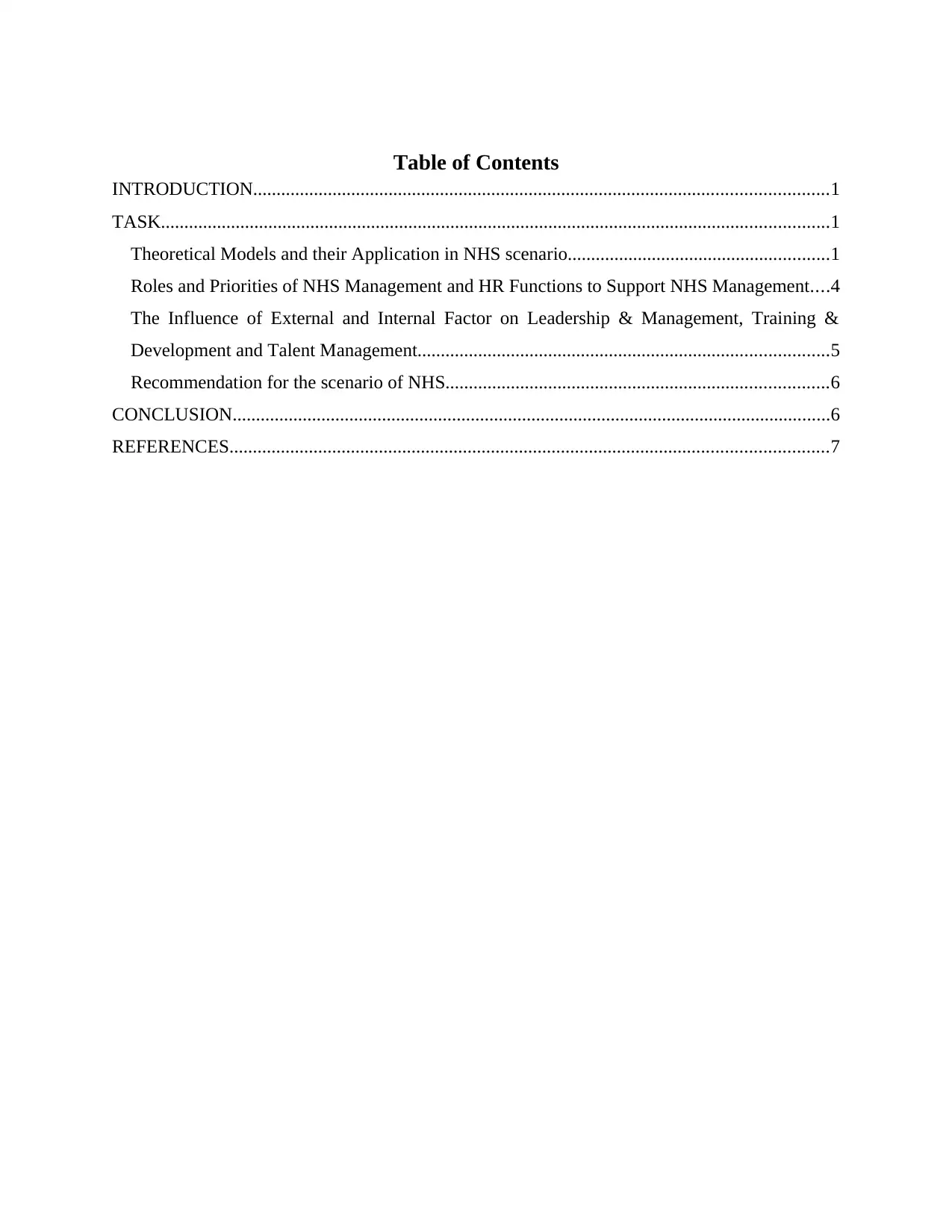
Table of Contents
INTRODUCTION...........................................................................................................................1
TASK...............................................................................................................................................1
Theoretical Models and their Application in NHS scenario........................................................1
Roles and Priorities of NHS Management and HR Functions to Support NHS Management....4
The Influence of External and Internal Factor on Leadership & Management, Training &
Development and Talent Management........................................................................................5
Recommendation for the scenario of NHS..................................................................................6
CONCLUSION................................................................................................................................6
REFERENCES................................................................................................................................7
INTRODUCTION...........................................................................................................................1
TASK...............................................................................................................................................1
Theoretical Models and their Application in NHS scenario........................................................1
Roles and Priorities of NHS Management and HR Functions to Support NHS Management....4
The Influence of External and Internal Factor on Leadership & Management, Training &
Development and Talent Management........................................................................................5
Recommendation for the scenario of NHS..................................................................................6
CONCLUSION................................................................................................................................6
REFERENCES................................................................................................................................7
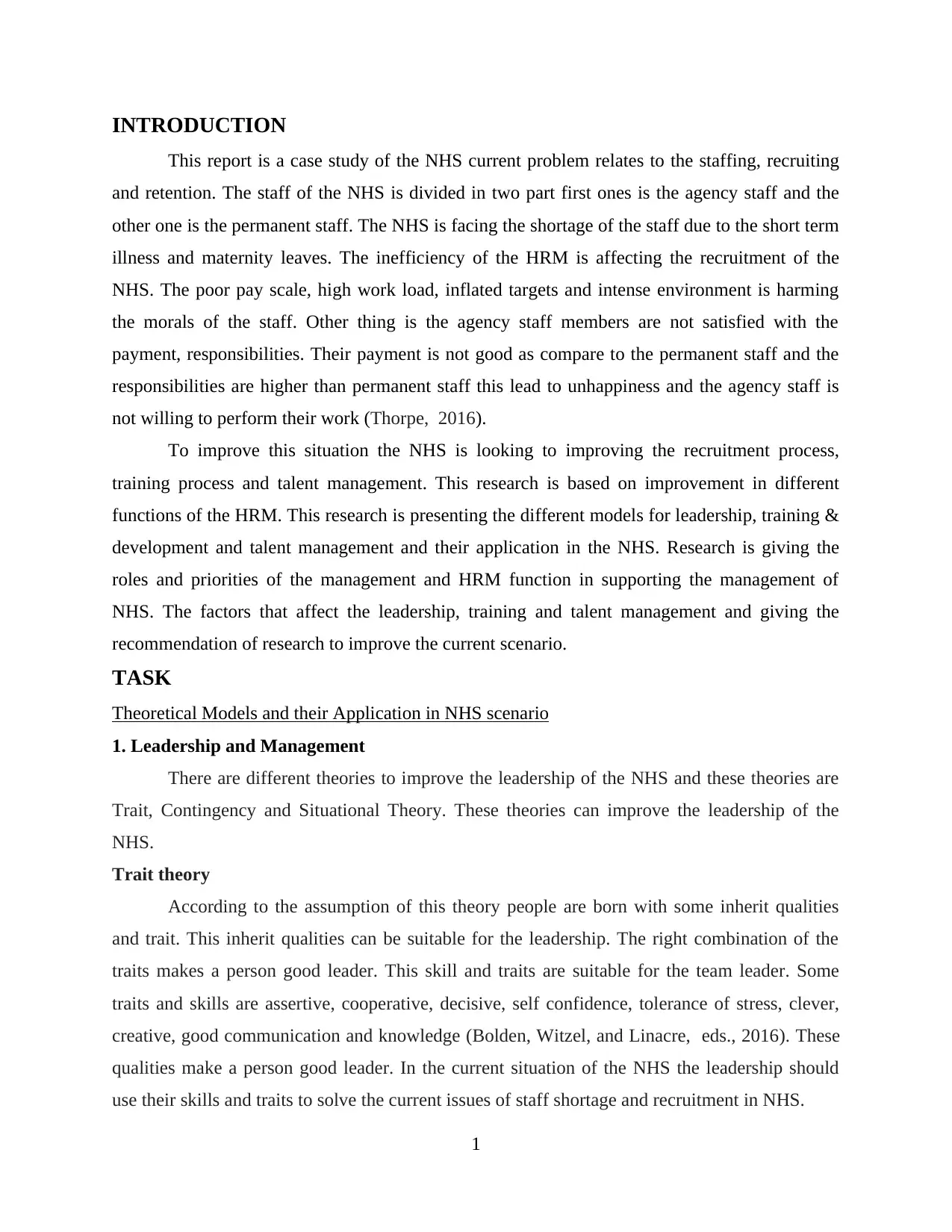
INTRODUCTION
This report is a case study of the NHS current problem relates to the staffing, recruiting
and retention. The staff of the NHS is divided in two part first ones is the agency staff and the
other one is the permanent staff. The NHS is facing the shortage of the staff due to the short term
illness and maternity leaves. The inefficiency of the HRM is affecting the recruitment of the
NHS. The poor pay scale, high work load, inflated targets and intense environment is harming
the morals of the staff. Other thing is the agency staff members are not satisfied with the
payment, responsibilities. Their payment is not good as compare to the permanent staff and the
responsibilities are higher than permanent staff this lead to unhappiness and the agency staff is
not willing to perform their work (Thorpe, 2016).
To improve this situation the NHS is looking to improving the recruitment process,
training process and talent management. This research is based on improvement in different
functions of the HRM. This research is presenting the different models for leadership, training &
development and talent management and their application in the NHS. Research is giving the
roles and priorities of the management and HRM function in supporting the management of
NHS. The factors that affect the leadership, training and talent management and giving the
recommendation of research to improve the current scenario.
TASK
Theoretical Models and their Application in NHS scenario
1. Leadership and Management
There are different theories to improve the leadership of the NHS and these theories are
Trait, Contingency and Situational Theory. These theories can improve the leadership of the
NHS.
Trait theory
According to the assumption of this theory people are born with some inherit qualities
and trait. This inherit qualities can be suitable for the leadership. The right combination of the
traits makes a person good leader. This skill and traits are suitable for the team leader. Some
traits and skills are assertive, cooperative, decisive, self confidence, tolerance of stress, clever,
creative, good communication and knowledge (Bolden, Witzel, and Linacre, eds., 2016). These
qualities make a person good leader. In the current situation of the NHS the leadership should
use their skills and traits to solve the current issues of staff shortage and recruitment in NHS.
1
This report is a case study of the NHS current problem relates to the staffing, recruiting
and retention. The staff of the NHS is divided in two part first ones is the agency staff and the
other one is the permanent staff. The NHS is facing the shortage of the staff due to the short term
illness and maternity leaves. The inefficiency of the HRM is affecting the recruitment of the
NHS. The poor pay scale, high work load, inflated targets and intense environment is harming
the morals of the staff. Other thing is the agency staff members are not satisfied with the
payment, responsibilities. Their payment is not good as compare to the permanent staff and the
responsibilities are higher than permanent staff this lead to unhappiness and the agency staff is
not willing to perform their work (Thorpe, 2016).
To improve this situation the NHS is looking to improving the recruitment process,
training process and talent management. This research is based on improvement in different
functions of the HRM. This research is presenting the different models for leadership, training &
development and talent management and their application in the NHS. Research is giving the
roles and priorities of the management and HRM function in supporting the management of
NHS. The factors that affect the leadership, training and talent management and giving the
recommendation of research to improve the current scenario.
TASK
Theoretical Models and their Application in NHS scenario
1. Leadership and Management
There are different theories to improve the leadership of the NHS and these theories are
Trait, Contingency and Situational Theory. These theories can improve the leadership of the
NHS.
Trait theory
According to the assumption of this theory people are born with some inherit qualities
and trait. This inherit qualities can be suitable for the leadership. The right combination of the
traits makes a person good leader. This skill and traits are suitable for the team leader. Some
traits and skills are assertive, cooperative, decisive, self confidence, tolerance of stress, clever,
creative, good communication and knowledge (Bolden, Witzel, and Linacre, eds., 2016). These
qualities make a person good leader. In the current situation of the NHS the leadership should
use their skills and traits to solve the current issues of staff shortage and recruitment in NHS.
1
⊘ This is a preview!⊘
Do you want full access?
Subscribe today to unlock all pages.

Trusted by 1+ million students worldwide
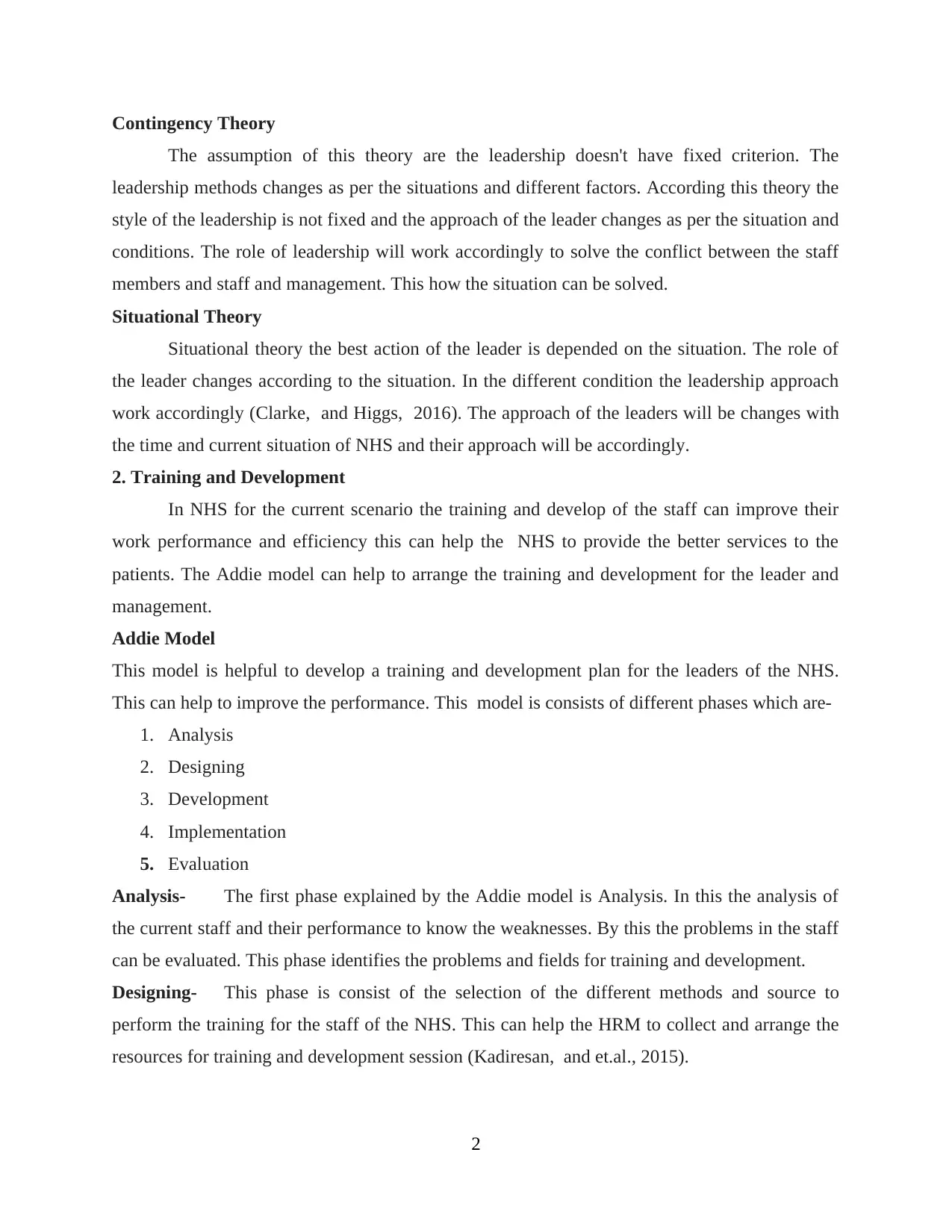
Contingency Theory
The assumption of this theory are the leadership doesn't have fixed criterion. The
leadership methods changes as per the situations and different factors. According this theory the
style of the leadership is not fixed and the approach of the leader changes as per the situation and
conditions. The role of leadership will work accordingly to solve the conflict between the staff
members and staff and management. This how the situation can be solved.
Situational Theory
Situational theory the best action of the leader is depended on the situation. The role of
the leader changes according to the situation. In the different condition the leadership approach
work accordingly (Clarke, and Higgs, 2016). The approach of the leaders will be changes with
the time and current situation of NHS and their approach will be accordingly.
2. Training and Development
In NHS for the current scenario the training and develop of the staff can improve their
work performance and efficiency this can help the NHS to provide the better services to the
patients. The Addie model can help to arrange the training and development for the leader and
management.
Addie Model
This model is helpful to develop a training and development plan for the leaders of the NHS.
This can help to improve the performance. This model is consists of different phases which are-
1. Analysis
2. Designing
3. Development
4. Implementation
5. Evaluation
Analysis- The first phase explained by the Addie model is Analysis. In this the analysis of
the current staff and their performance to know the weaknesses. By this the problems in the staff
can be evaluated. This phase identifies the problems and fields for training and development.
Designing- This phase is consist of the selection of the different methods and source to
perform the training for the staff of the NHS. This can help the HRM to collect and arrange the
resources for training and development session (Kadiresan, and et.al., 2015).
2
The assumption of this theory are the leadership doesn't have fixed criterion. The
leadership methods changes as per the situations and different factors. According this theory the
style of the leadership is not fixed and the approach of the leader changes as per the situation and
conditions. The role of leadership will work accordingly to solve the conflict between the staff
members and staff and management. This how the situation can be solved.
Situational Theory
Situational theory the best action of the leader is depended on the situation. The role of
the leader changes according to the situation. In the different condition the leadership approach
work accordingly (Clarke, and Higgs, 2016). The approach of the leaders will be changes with
the time and current situation of NHS and their approach will be accordingly.
2. Training and Development
In NHS for the current scenario the training and develop of the staff can improve their
work performance and efficiency this can help the NHS to provide the better services to the
patients. The Addie model can help to arrange the training and development for the leader and
management.
Addie Model
This model is helpful to develop a training and development plan for the leaders of the NHS.
This can help to improve the performance. This model is consists of different phases which are-
1. Analysis
2. Designing
3. Development
4. Implementation
5. Evaluation
Analysis- The first phase explained by the Addie model is Analysis. In this the analysis of
the current staff and their performance to know the weaknesses. By this the problems in the staff
can be evaluated. This phase identifies the problems and fields for training and development.
Designing- This phase is consist of the selection of the different methods and source to
perform the training for the staff of the NHS. This can help the HRM to collect and arrange the
resources for training and development session (Kadiresan, and et.al., 2015).
2
Paraphrase This Document
Need a fresh take? Get an instant paraphrase of this document with our AI Paraphraser
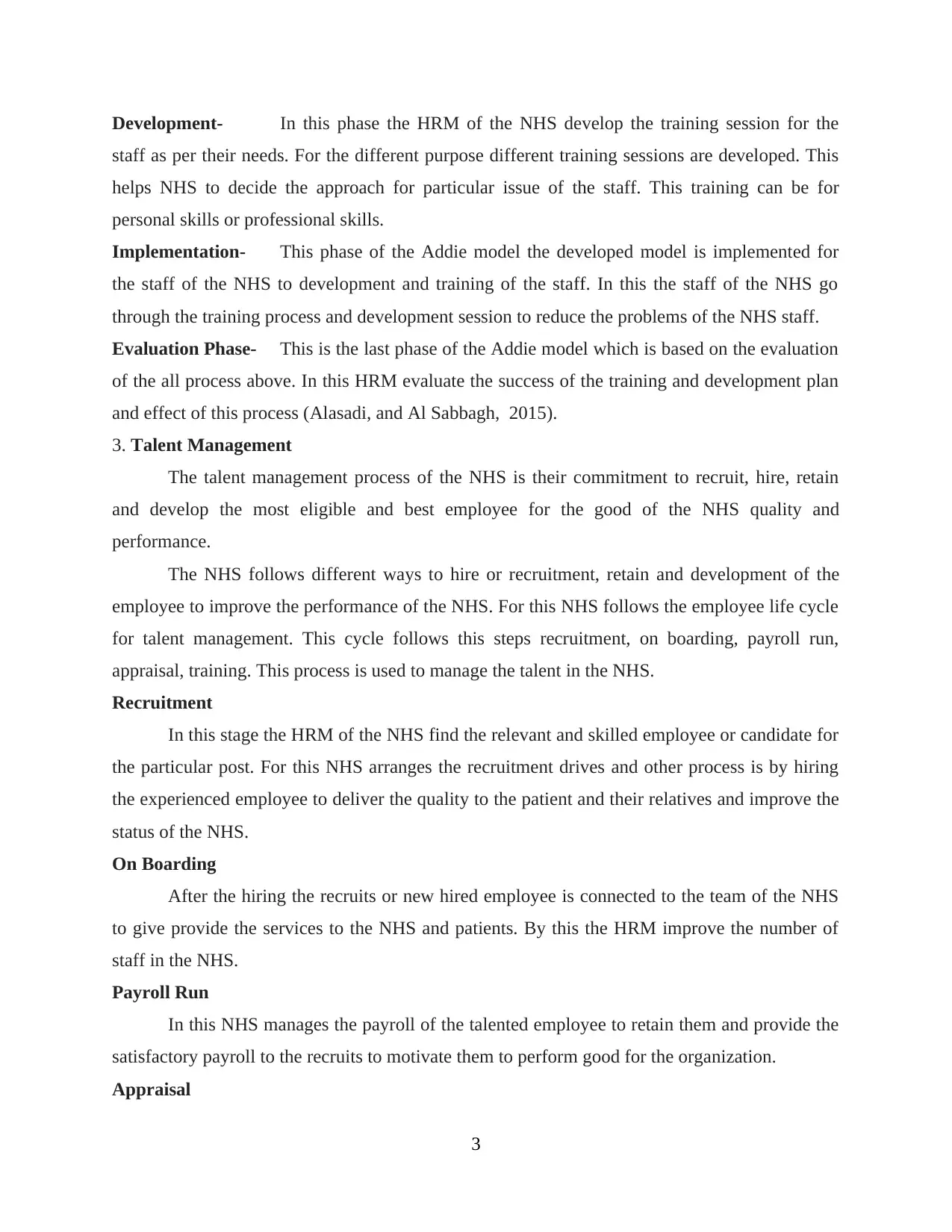
Development- In this phase the HRM of the NHS develop the training session for the
staff as per their needs. For the different purpose different training sessions are developed. This
helps NHS to decide the approach for particular issue of the staff. This training can be for
personal skills or professional skills.
Implementation- This phase of the Addie model the developed model is implemented for
the staff of the NHS to development and training of the staff. In this the staff of the NHS go
through the training process and development session to reduce the problems of the NHS staff.
Evaluation Phase- This is the last phase of the Addie model which is based on the evaluation
of the all process above. In this HRM evaluate the success of the training and development plan
and effect of this process (Alasadi, and Al Sabbagh, 2015).
3. Talent Management
The talent management process of the NHS is their commitment to recruit, hire, retain
and develop the most eligible and best employee for the good of the NHS quality and
performance.
The NHS follows different ways to hire or recruitment, retain and development of the
employee to improve the performance of the NHS. For this NHS follows the employee life cycle
for talent management. This cycle follows this steps recruitment, on boarding, payroll run,
appraisal, training. This process is used to manage the talent in the NHS.
Recruitment
In this stage the HRM of the NHS find the relevant and skilled employee or candidate for
the particular post. For this NHS arranges the recruitment drives and other process is by hiring
the experienced employee to deliver the quality to the patient and their relatives and improve the
status of the NHS.
On Boarding
After the hiring the recruits or new hired employee is connected to the team of the NHS
to give provide the services to the NHS and patients. By this the HRM improve the number of
staff in the NHS.
Payroll Run
In this NHS manages the payroll of the talented employee to retain them and provide the
satisfactory payroll to the recruits to motivate them to perform good for the organization.
Appraisal
3
staff as per their needs. For the different purpose different training sessions are developed. This
helps NHS to decide the approach for particular issue of the staff. This training can be for
personal skills or professional skills.
Implementation- This phase of the Addie model the developed model is implemented for
the staff of the NHS to development and training of the staff. In this the staff of the NHS go
through the training process and development session to reduce the problems of the NHS staff.
Evaluation Phase- This is the last phase of the Addie model which is based on the evaluation
of the all process above. In this HRM evaluate the success of the training and development plan
and effect of this process (Alasadi, and Al Sabbagh, 2015).
3. Talent Management
The talent management process of the NHS is their commitment to recruit, hire, retain
and develop the most eligible and best employee for the good of the NHS quality and
performance.
The NHS follows different ways to hire or recruitment, retain and development of the
employee to improve the performance of the NHS. For this NHS follows the employee life cycle
for talent management. This cycle follows this steps recruitment, on boarding, payroll run,
appraisal, training. This process is used to manage the talent in the NHS.
Recruitment
In this stage the HRM of the NHS find the relevant and skilled employee or candidate for
the particular post. For this NHS arranges the recruitment drives and other process is by hiring
the experienced employee to deliver the quality to the patient and their relatives and improve the
status of the NHS.
On Boarding
After the hiring the recruits or new hired employee is connected to the team of the NHS
to give provide the services to the NHS and patients. By this the HRM improve the number of
staff in the NHS.
Payroll Run
In this NHS manages the payroll of the talented employee to retain them and provide the
satisfactory payroll to the recruits to motivate them to perform good for the organization.
Appraisal
3
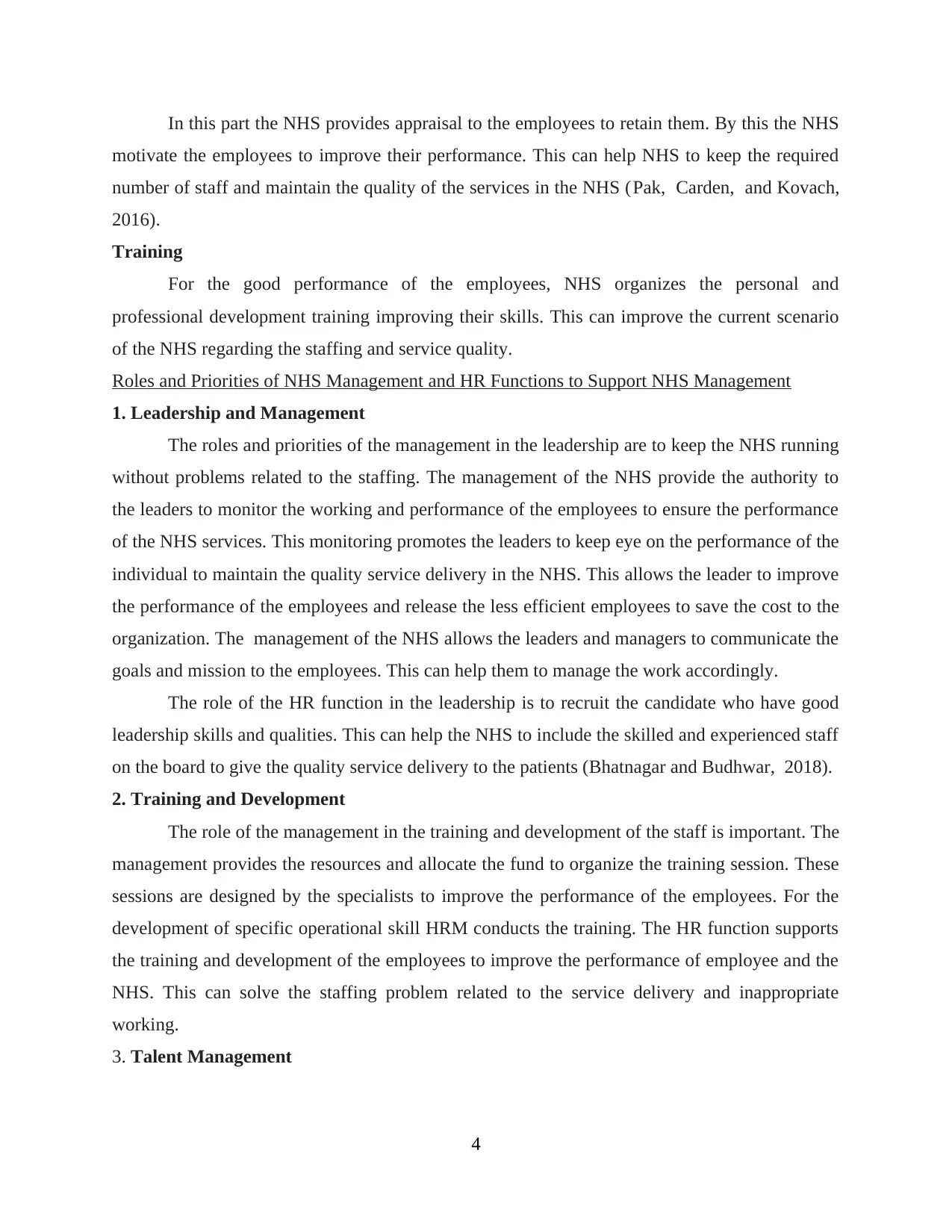
In this part the NHS provides appraisal to the employees to retain them. By this the NHS
motivate the employees to improve their performance. This can help NHS to keep the required
number of staff and maintain the quality of the services in the NHS (Pak, Carden, and Kovach,
2016).
Training
For the good performance of the employees, NHS organizes the personal and
professional development training improving their skills. This can improve the current scenario
of the NHS regarding the staffing and service quality.
Roles and Priorities of NHS Management and HR Functions to Support NHS Management
1. Leadership and Management
The roles and priorities of the management in the leadership are to keep the NHS running
without problems related to the staffing. The management of the NHS provide the authority to
the leaders to monitor the working and performance of the employees to ensure the performance
of the NHS services. This monitoring promotes the leaders to keep eye on the performance of the
individual to maintain the quality service delivery in the NHS. This allows the leader to improve
the performance of the employees and release the less efficient employees to save the cost to the
organization. The management of the NHS allows the leaders and managers to communicate the
goals and mission to the employees. This can help them to manage the work accordingly.
The role of the HR function in the leadership is to recruit the candidate who have good
leadership skills and qualities. This can help the NHS to include the skilled and experienced staff
on the board to give the quality service delivery to the patients (Bhatnagar and Budhwar, 2018).
2. Training and Development
The role of the management in the training and development of the staff is important. The
management provides the resources and allocate the fund to organize the training session. These
sessions are designed by the specialists to improve the performance of the employees. For the
development of specific operational skill HRM conducts the training. The HR function supports
the training and development of the employees to improve the performance of employee and the
NHS. This can solve the staffing problem related to the service delivery and inappropriate
working.
3. Talent Management
4
motivate the employees to improve their performance. This can help NHS to keep the required
number of staff and maintain the quality of the services in the NHS (Pak, Carden, and Kovach,
2016).
Training
For the good performance of the employees, NHS organizes the personal and
professional development training improving their skills. This can improve the current scenario
of the NHS regarding the staffing and service quality.
Roles and Priorities of NHS Management and HR Functions to Support NHS Management
1. Leadership and Management
The roles and priorities of the management in the leadership are to keep the NHS running
without problems related to the staffing. The management of the NHS provide the authority to
the leaders to monitor the working and performance of the employees to ensure the performance
of the NHS services. This monitoring promotes the leaders to keep eye on the performance of the
individual to maintain the quality service delivery in the NHS. This allows the leader to improve
the performance of the employees and release the less efficient employees to save the cost to the
organization. The management of the NHS allows the leaders and managers to communicate the
goals and mission to the employees. This can help them to manage the work accordingly.
The role of the HR function in the leadership is to recruit the candidate who have good
leadership skills and qualities. This can help the NHS to include the skilled and experienced staff
on the board to give the quality service delivery to the patients (Bhatnagar and Budhwar, 2018).
2. Training and Development
The role of the management in the training and development of the staff is important. The
management provides the resources and allocate the fund to organize the training session. These
sessions are designed by the specialists to improve the performance of the employees. For the
development of specific operational skill HRM conducts the training. The HR function supports
the training and development of the employees to improve the performance of employee and the
NHS. This can solve the staffing problem related to the service delivery and inappropriate
working.
3. Talent Management
4
⊘ This is a preview!⊘
Do you want full access?
Subscribe today to unlock all pages.

Trusted by 1+ million students worldwide
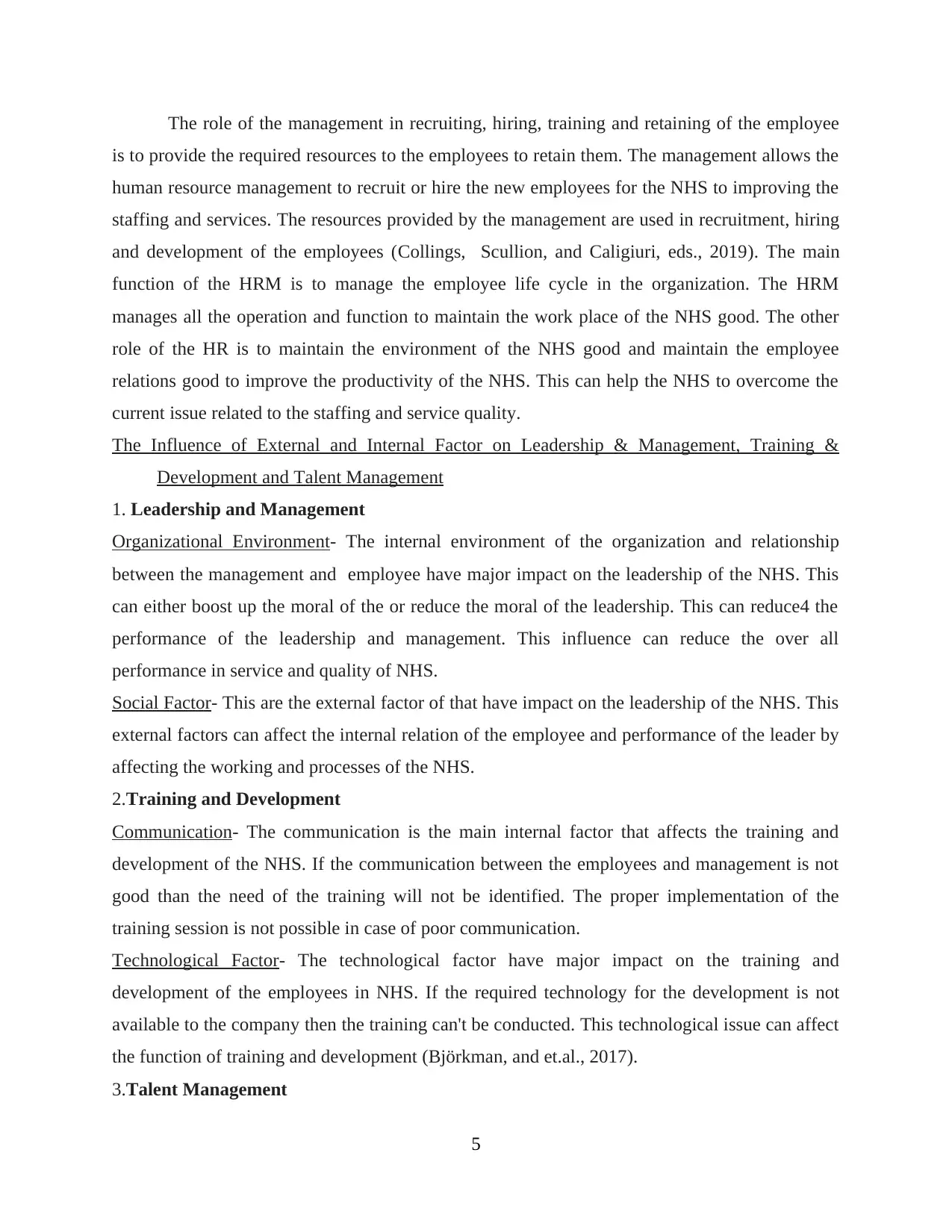
The role of the management in recruiting, hiring, training and retaining of the employee
is to provide the required resources to the employees to retain them. The management allows the
human resource management to recruit or hire the new employees for the NHS to improving the
staffing and services. The resources provided by the management are used in recruitment, hiring
and development of the employees (Collings, Scullion, and Caligiuri, eds., 2019). The main
function of the HRM is to manage the employee life cycle in the organization. The HRM
manages all the operation and function to maintain the work place of the NHS good. The other
role of the HR is to maintain the environment of the NHS good and maintain the employee
relations good to improve the productivity of the NHS. This can help the NHS to overcome the
current issue related to the staffing and service quality.
The Influence of External and Internal Factor on Leadership & Management, Training &
Development and Talent Management
1. Leadership and Management
Organizational Environment- The internal environment of the organization and relationship
between the management and employee have major impact on the leadership of the NHS. This
can either boost up the moral of the or reduce the moral of the leadership. This can reduce4 the
performance of the leadership and management. This influence can reduce the over all
performance in service and quality of NHS.
Social Factor- This are the external factor of that have impact on the leadership of the NHS. This
external factors can affect the internal relation of the employee and performance of the leader by
affecting the working and processes of the NHS.
2.Training and Development
Communication- The communication is the main internal factor that affects the training and
development of the NHS. If the communication between the employees and management is not
good than the need of the training will not be identified. The proper implementation of the
training session is not possible in case of poor communication.
Technological Factor- The technological factor have major impact on the training and
development of the employees in NHS. If the required technology for the development is not
available to the company then the training can't be conducted. This technological issue can affect
the function of training and development (Björkman, and et.al., 2017).
3.Talent Management
5
is to provide the required resources to the employees to retain them. The management allows the
human resource management to recruit or hire the new employees for the NHS to improving the
staffing and services. The resources provided by the management are used in recruitment, hiring
and development of the employees (Collings, Scullion, and Caligiuri, eds., 2019). The main
function of the HRM is to manage the employee life cycle in the organization. The HRM
manages all the operation and function to maintain the work place of the NHS good. The other
role of the HR is to maintain the environment of the NHS good and maintain the employee
relations good to improve the productivity of the NHS. This can help the NHS to overcome the
current issue related to the staffing and service quality.
The Influence of External and Internal Factor on Leadership & Management, Training &
Development and Talent Management
1. Leadership and Management
Organizational Environment- The internal environment of the organization and relationship
between the management and employee have major impact on the leadership of the NHS. This
can either boost up the moral of the or reduce the moral of the leadership. This can reduce4 the
performance of the leadership and management. This influence can reduce the over all
performance in service and quality of NHS.
Social Factor- This are the external factor of that have impact on the leadership of the NHS. This
external factors can affect the internal relation of the employee and performance of the leader by
affecting the working and processes of the NHS.
2.Training and Development
Communication- The communication is the main internal factor that affects the training and
development of the NHS. If the communication between the employees and management is not
good than the need of the training will not be identified. The proper implementation of the
training session is not possible in case of poor communication.
Technological Factor- The technological factor have major impact on the training and
development of the employees in NHS. If the required technology for the development is not
available to the company then the training can't be conducted. This technological issue can affect
the function of training and development (Björkman, and et.al., 2017).
3.Talent Management
5
Paraphrase This Document
Need a fresh take? Get an instant paraphrase of this document with our AI Paraphraser
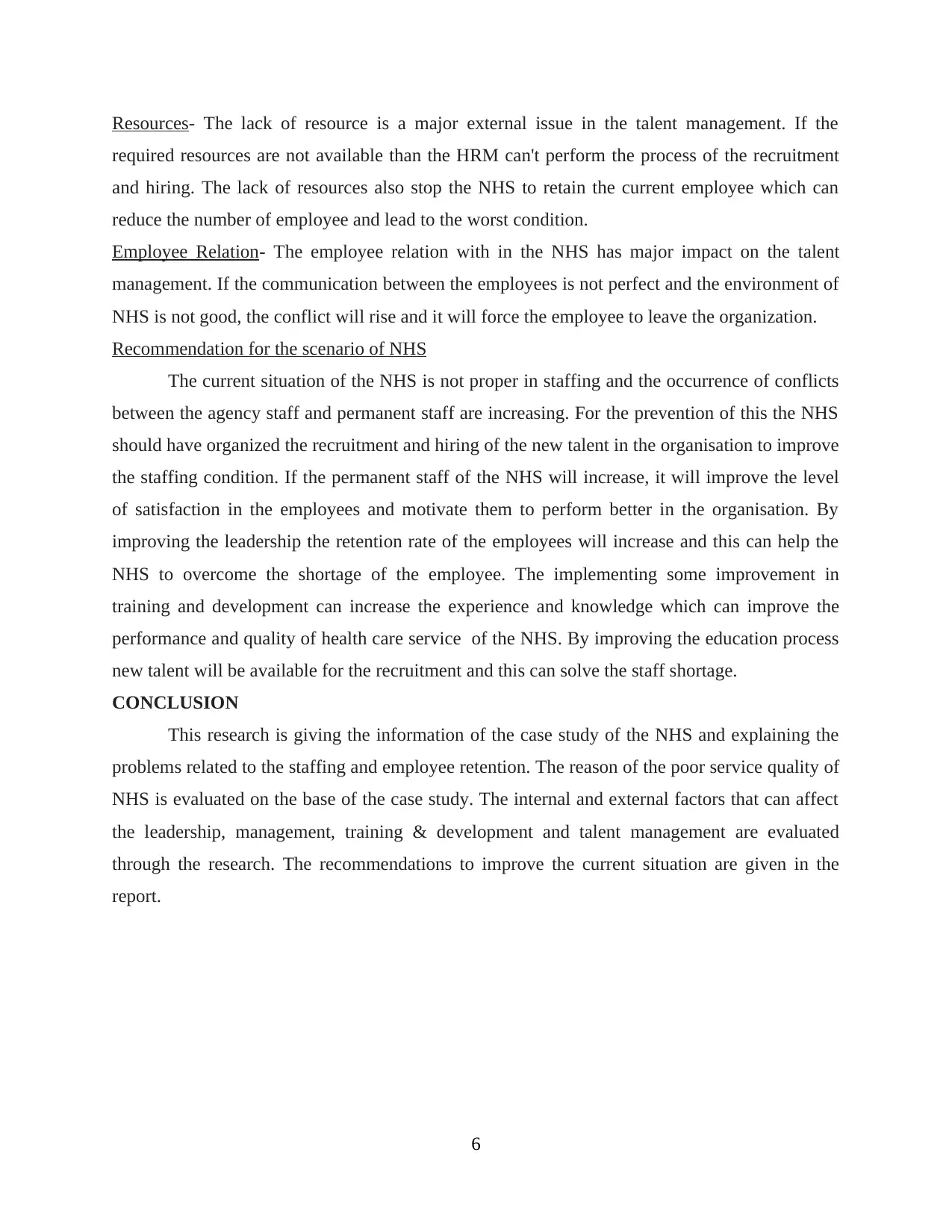
Resources- The lack of resource is a major external issue in the talent management. If the
required resources are not available than the HRM can't perform the process of the recruitment
and hiring. The lack of resources also stop the NHS to retain the current employee which can
reduce the number of employee and lead to the worst condition.
Employee Relation- The employee relation with in the NHS has major impact on the talent
management. If the communication between the employees is not perfect and the environment of
NHS is not good, the conflict will rise and it will force the employee to leave the organization.
Recommendation for the scenario of NHS
The current situation of the NHS is not proper in staffing and the occurrence of conflicts
between the agency staff and permanent staff are increasing. For the prevention of this the NHS
should have organized the recruitment and hiring of the new talent in the organisation to improve
the staffing condition. If the permanent staff of the NHS will increase, it will improve the level
of satisfaction in the employees and motivate them to perform better in the organisation. By
improving the leadership the retention rate of the employees will increase and this can help the
NHS to overcome the shortage of the employee. The implementing some improvement in
training and development can increase the experience and knowledge which can improve the
performance and quality of health care service of the NHS. By improving the education process
new talent will be available for the recruitment and this can solve the staff shortage.
CONCLUSION
This research is giving the information of the case study of the NHS and explaining the
problems related to the staffing and employee retention. The reason of the poor service quality of
NHS is evaluated on the base of the case study. The internal and external factors that can affect
the leadership, management, training & development and talent management are evaluated
through the research. The recommendations to improve the current situation are given in the
report.
6
required resources are not available than the HRM can't perform the process of the recruitment
and hiring. The lack of resources also stop the NHS to retain the current employee which can
reduce the number of employee and lead to the worst condition.
Employee Relation- The employee relation with in the NHS has major impact on the talent
management. If the communication between the employees is not perfect and the environment of
NHS is not good, the conflict will rise and it will force the employee to leave the organization.
Recommendation for the scenario of NHS
The current situation of the NHS is not proper in staffing and the occurrence of conflicts
between the agency staff and permanent staff are increasing. For the prevention of this the NHS
should have organized the recruitment and hiring of the new talent in the organisation to improve
the staffing condition. If the permanent staff of the NHS will increase, it will improve the level
of satisfaction in the employees and motivate them to perform better in the organisation. By
improving the leadership the retention rate of the employees will increase and this can help the
NHS to overcome the shortage of the employee. The implementing some improvement in
training and development can increase the experience and knowledge which can improve the
performance and quality of health care service of the NHS. By improving the education process
new talent will be available for the recruitment and this can solve the staff shortage.
CONCLUSION
This research is giving the information of the case study of the NHS and explaining the
problems related to the staffing and employee retention. The reason of the poor service quality of
NHS is evaluated on the base of the case study. The internal and external factors that can affect
the leadership, management, training & development and talent management are evaluated
through the research. The recommendations to improve the current situation are given in the
report.
6
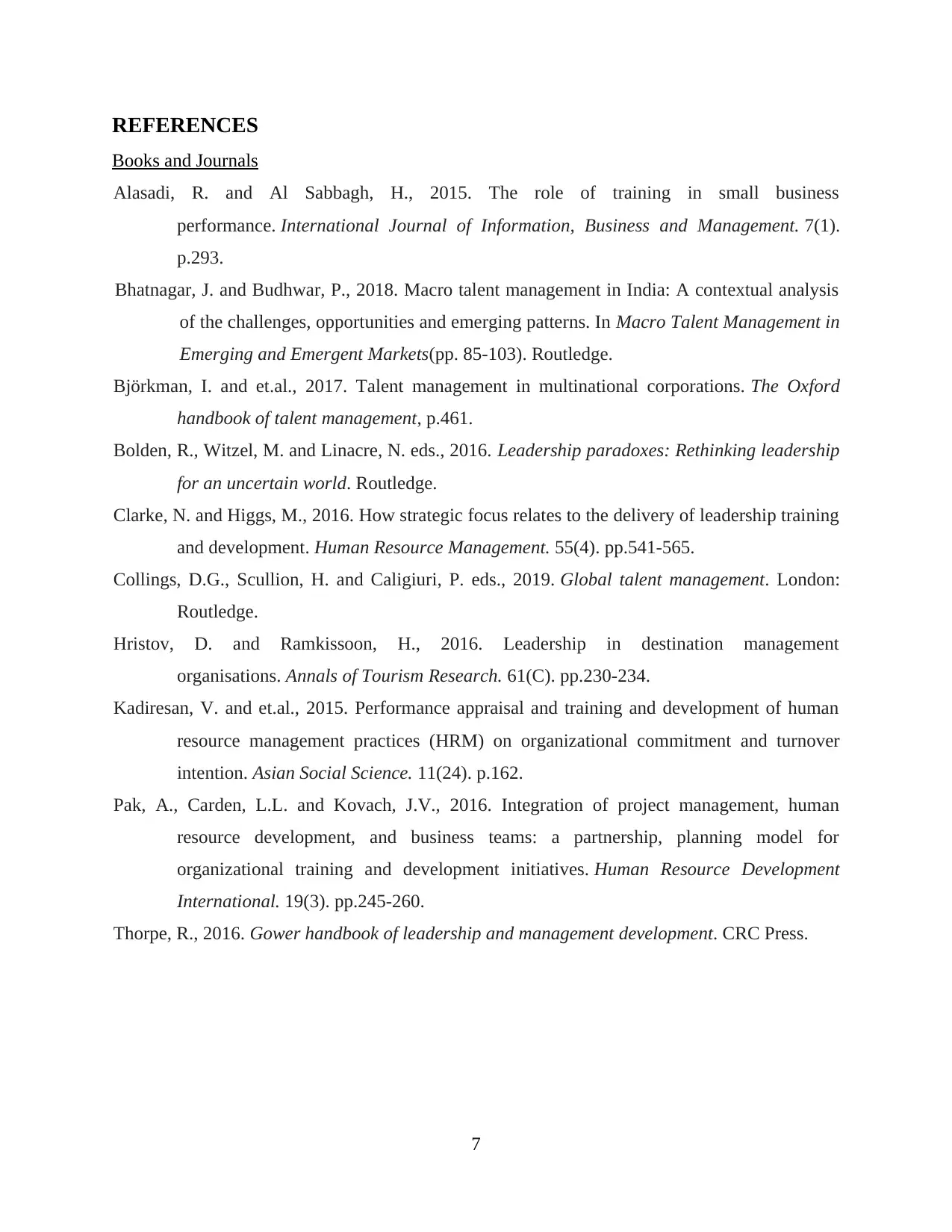
REFERENCES
Books and Journals
Alasadi, R. and Al Sabbagh, H., 2015. The role of training in small business
performance. International Journal of Information, Business and Management. 7(1).
p.293.
Bhatnagar, J. and Budhwar, P., 2018. Macro talent management in India: A contextual analysis
of the challenges, opportunities and emerging patterns. In Macro Talent Management in
Emerging and Emergent Markets(pp. 85-103). Routledge.
Björkman, I. and et.al., 2017. Talent management in multinational corporations. The Oxford
handbook of talent management, p.461.
Bolden, R., Witzel, M. and Linacre, N. eds., 2016. Leadership paradoxes: Rethinking leadership
for an uncertain world. Routledge.
Clarke, N. and Higgs, M., 2016. How strategic focus relates to the delivery of leadership training
and development. Human Resource Management. 55(4). pp.541-565.
Collings, D.G., Scullion, H. and Caligiuri, P. eds., 2019. Global talent management. London:
Routledge.
Hristov, D. and Ramkissoon, H., 2016. Leadership in destination management
organisations. Annals of Tourism Research. 61(C). pp.230-234.
Kadiresan, V. and et.al., 2015. Performance appraisal and training and development of human
resource management practices (HRM) on organizational commitment and turnover
intention. Asian Social Science. 11(24). p.162.
Pak, A., Carden, L.L. and Kovach, J.V., 2016. Integration of project management, human
resource development, and business teams: a partnership, planning model for
organizational training and development initiatives. Human Resource Development
International. 19(3). pp.245-260.
Thorpe, R., 2016. Gower handbook of leadership and management development. CRC Press.
7
Books and Journals
Alasadi, R. and Al Sabbagh, H., 2015. The role of training in small business
performance. International Journal of Information, Business and Management. 7(1).
p.293.
Bhatnagar, J. and Budhwar, P., 2018. Macro talent management in India: A contextual analysis
of the challenges, opportunities and emerging patterns. In Macro Talent Management in
Emerging and Emergent Markets(pp. 85-103). Routledge.
Björkman, I. and et.al., 2017. Talent management in multinational corporations. The Oxford
handbook of talent management, p.461.
Bolden, R., Witzel, M. and Linacre, N. eds., 2016. Leadership paradoxes: Rethinking leadership
for an uncertain world. Routledge.
Clarke, N. and Higgs, M., 2016. How strategic focus relates to the delivery of leadership training
and development. Human Resource Management. 55(4). pp.541-565.
Collings, D.G., Scullion, H. and Caligiuri, P. eds., 2019. Global talent management. London:
Routledge.
Hristov, D. and Ramkissoon, H., 2016. Leadership in destination management
organisations. Annals of Tourism Research. 61(C). pp.230-234.
Kadiresan, V. and et.al., 2015. Performance appraisal and training and development of human
resource management practices (HRM) on organizational commitment and turnover
intention. Asian Social Science. 11(24). p.162.
Pak, A., Carden, L.L. and Kovach, J.V., 2016. Integration of project management, human
resource development, and business teams: a partnership, planning model for
organizational training and development initiatives. Human Resource Development
International. 19(3). pp.245-260.
Thorpe, R., 2016. Gower handbook of leadership and management development. CRC Press.
7
⊘ This is a preview!⊘
Do you want full access?
Subscribe today to unlock all pages.

Trusted by 1+ million students worldwide
1 out of 9
Related Documents
Your All-in-One AI-Powered Toolkit for Academic Success.
+13062052269
info@desklib.com
Available 24*7 on WhatsApp / Email
![[object Object]](/_next/static/media/star-bottom.7253800d.svg)
Unlock your academic potential
Copyright © 2020–2025 A2Z Services. All Rights Reserved. Developed and managed by ZUCOL.





